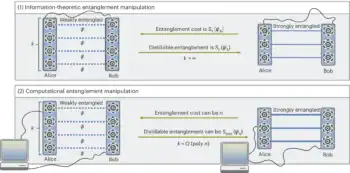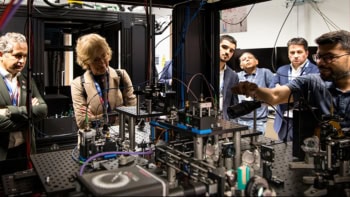
Researchers have found quantitative evidence for a mechanism long predicted to be responsible for high-temperature superconductivity. Led by JC Séamus Davis of the University of Oxford, UK, the team used quantum microscopy to study a high-temperature superconductor called bismuth strontium calcium copper oxide (BSCCO). The work reveals that electrons in this material appear to enter a superfluid state due to strong electron pairing, which then allows them to move without any dissipation.
Superconductors are materials that conduct electricity without any resistance when cooled below their superconducting transition temperature, Tc. The first superconductor to be discovered was solid mercury in 1911, but its transition temperature is only a few kelvin above absolute zero, meaning that expensive liquid helium coolant is required to keep it in the superconducting phase. Several other “conventional” superconductors, as they are known, were discovered shortly afterwards, with similarly frigid values of Tc.
Beginning in the late 1980s, however, a new class of “high-temperature” superconductors with Tc above the boiling point of liquid nitrogen (77 K) emerged. These materials were not metals but insulators containing copper oxides (cuprates), and their existence suggested that it might be possible to achieve superconductivity at even higher temperatures. The search for room-temperature superconductors has been going on ever since, as such materials would considerably improve the efficiency of electrical generators and transmission lines, while also making common applications of superconductivity (including superconducting magnets in particle accelerators and medical devices like MRI scanners) simpler and cheaper.
BCS theory falls short
The classical theory of superconductivity (known as BCS theory after the initials of its discoverers, Bardeen, Cooper and Schrieffer) explains why mercury and most metallic elements superconduct below their Tc: their fermionic electrons pair up to create bosons called Cooper pairs. These bosons form a phase-coherent condensate that can flow through the material as a supercurrent that does not experience scattering, and superconductivity is a consequence of this. The theory falls short, however, when it comes to explaining the mechanisms behind high-temperature superconductors. Indeed, the mechanism behind high temperature superconductivity is regarded as one of the fundamental unsolved problems in physics.
One possible theory, put forward by the late American physicist and Nobel laureate Philip Anderson, involves a quantum phenomenon called superexchange. Unlike the more familiar exchange interaction, which affects electrons that are physically close enough to have overlapping quantum-mechanical wavefunctions, superexchange does not require overlap. Instead, it stems from the electrons “hopping” from the copper atom at one lattice site in a crystalline material to another copper atom at the next site – a quantum mechanical process in which the electron tunnels through the oxygen atoms that separate the two copper atoms. During this process, the electron “virtually’ visits its neighbour, only to hop back again picoseconds later.
A key point in Anderson’s superexchange theory is that it implies that electrons seek out situations in which they can more optimally hop – for example, when the spins of neighbouring electrons point in opposite directions, establishing a regular spin-up/spin-down pattern. The virtual hopping phenomenon also forces electrons to remain relatively close to each other, providing a powerful type of quantum attraction that could help form strong Cooper pairs.
Measuring a current of electron pairs
Until now, it had been difficult to test such a theory, but Davis and colleagues found a way to do it using a modified scanning tunnelling microscope (STM) with a superconducting tip rather than the usual normal metallic one. By sweeping this superconducting tip across a sample of BSCCO, they were able to measure a current of electron pairs, rather than just a current of individual electrons. This allowed them to map the density of Cooper pairs surrounding each atom – a direct measure of superconductivity.
Spearheaded by Shane O’Mahony at University College Cork in Ireland and Wangping Ren at the University of Oxford, Davis’ team found that when electron hopping was more difficult, superconductivity was weaker. Conversely, when hopping was easy, superconductivity was strong. This observation was quantitatively in excellent agreement with the superexchange pairing theory, which can now be analysed numerically, say the researchers, and it strongly implies that superexchange is the electron-pairing mechanism in superconductive BSCCO.

“If this new experimental technique and approach validates a specific theory as being accurately predictive, it should allow theorists to design synthetic materials with different atoms in different locations for which the Tc is higher,” Davis says. “Ultimately, these materials could have far-reaching applications, ranging from maglev trains, nuclear fusion reactors, quantum computers and high-energy particle accelerators, not to mention super-efficient energy transfer and storage.”
According to Cedric Weber of Kings College London, who was not involved in the work, Davis’ team “pioneered new possibilities in our understanding of the microscopic origin of high temperature superconductivity, in particular within the context of the problem of strongly interacting electrons”. Such theories are inherently hard to solve, Weber adds, and the aim is to identify key quantities that can provide markers to achieve room-temperature operations.

Cuprate superconductors contain a strange component
“The researchers achieved a tour de force and provided a systematic study of the superconducting properties with respect to changes in the charge-transfer energy, and demonstrating the key relevance of this parameter,” Weber says. “The charge-transfer energy is also a particular variable that defines the super-exchange coupling. This not only brings theory and experiments much closer, it is also a leap towards providing a roadmap for ultimately designing better superconductors.”
The Oxford–Cork team, reporting its work in PNAS, says it will use the new technique to explore the phase diagram of the high-temperature superconducting cuprates to test the theory they have validated experimentally for a range of different parameters. “If successful, we will then attempt equivalent studies of other materials,” Davis tells Physics World.



